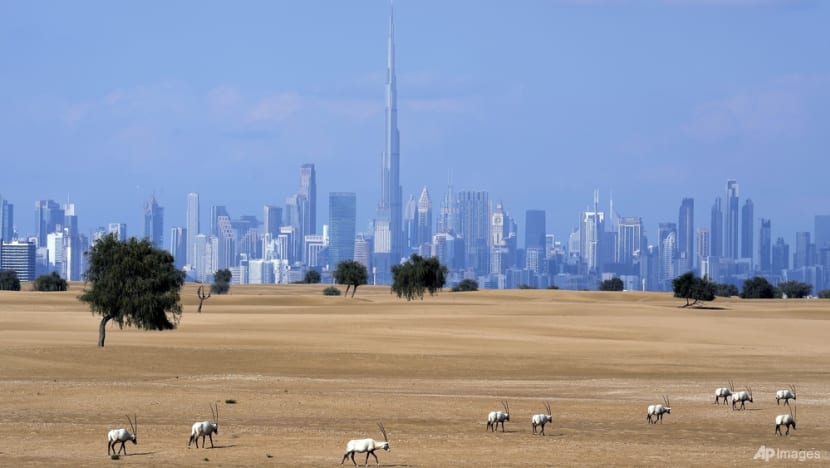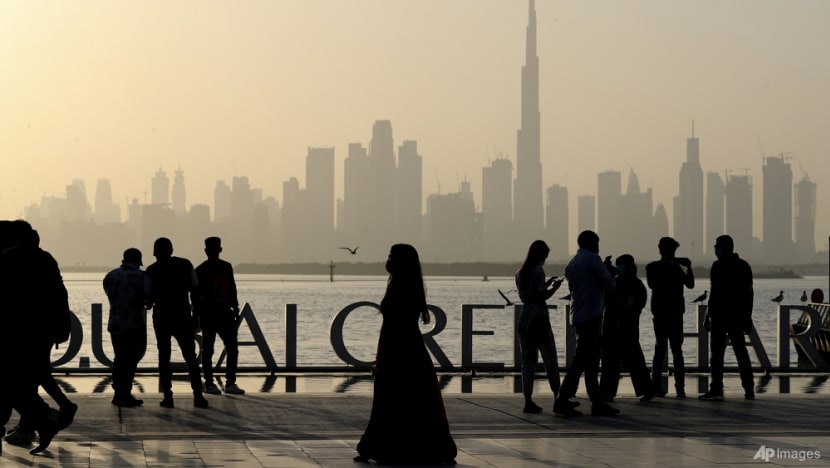With little natural resources, Dubai turns to science and technology for its water
Dubai, a desert city where water is precious, has undertaken an ambitious journey in water management with sights set on a more sustainable future.

FILE - A flock of Arabian Oryx graze at a conservation area in front of the city skyline with the Burj Khalifa, the world's tallest building, in Dubai, United Arab Emirates, Jan. 8, 2023. Dubai hosts the United Nations COP28 climate talks starting Nov. 30. (AP Photo/Kamran Jebreili, File)

This audio is generated by an AI tool.
DUBAI: In the heart of Dubai is a structure that might strike some as remarkable in a region known for its water scarcity.
Deep Dive Dubai is the deepest swimming pool in the world, with a capacity equivalent to six Olympic-size pools.
At 60m, its depth is the height of a 20-storey building or a Boeing 777 standing on its nose.
Filled with 14 million litres of fresh water, it allows visitors to take part in a range of diving activities.
Managers of the attraction said maintaining a pool of this magnitude in a sustainable way is no small feat.
“My job and the job of Deep Dive Dubai is to make sure that we use (the water) as efficiently as possible, that we use as efficient techniques as possible to clean and disinfect it… and make sure that we don't have to replace much water,” said the firm’s technical manager Richard Lundgren.
The facility invests heavily in top-notch treatment and filtration technology to keep the water fresh while reducing the impact on the environment.
It uses ozone treatment, which cuts down chlorine usage by 80 per cent.
“Ozone is a very powerful disinfectant, more effective than chemicals and chloride. It basically takes the source of oxygen into the water, and leaves zero residues. With this system, we can reduce almost to zero the amount of water we have to replace over the year,” said Mr Lundgren.
UAE’S WATER PROBLEM
Dubai's tourist sites – including the deep pool, more than 20 golf courses and the world’s largest natural flower garden – may seem extravagant in a region known for its hot and dry climate.
Temperatures can hit highs of 50 degrees Celsius in the summer.
The United Arab Emirates – where Dubai is the most populous city – has some of the lowest rainfall in the world. Its average precipitation is 140-200mm according to the World Bank, compared to the global average of about 1,000mm.
It is also facing threats of rapid population growth and climate change.
According to recent studies, the most water-stressed regions in the world are the Middle East and North Africa.
About 83 per cent of the population in those areas are exposed to extremely high water stress.
With global water demand set to rise by up to 25 per cent by 2050, residents in these regions could experience severe water scarcity.
To tackle these challenges, the UAE, like most countries with deep pockets, is tapping into its resources to maintain lush landscapes and ensure water security for its population of 9.5 million people.
WHERE DOES DUBAI’S WATER COME FROM?
Seawater desalination has been a lifeline in Dubai, like in the rest of the Emirates, for almost 50 years.
Last year, Dubai Electricity and Water Authority (DEWA) supplied water to more than 3.6 million residents.
But this method, while effective, comes with drawbacks. It is energy-intensive, expensive, and has significant environmental costs.
“One of the most dangerous (drawbacks) is how to deal with the brine – when we have large amounts of desalinated water, we have to deal with it. We need to dump it somewhere,” said Associate Professor Ammar Alkhalidi, from University of Sharjah’s College of Engineering.
“We have seen cases of misuse of brine water that have caused much, much worse problems, so brine has to be dealt with carefully.”

Brine is a by-product of seawater desalination, with a high concentration of salt as well as other chemicals, organics and heavy metals. When disposed of irresponsibly, it can have an adverse impact on the environment.
DEWA said it has a solution to its brine problem – an eco-friendly technology called reverse osmosis.
Unlike the traditional method of flash distillation, which relies on heat, this process removes salt and other contaminants by pushing water through a semi-permeable membrane.
“It's virtually like cotton or a sheet. It allows the water to pass through and blocks all the minerals and impurities that could be in the sea. So the water (is filtered) without producing any extra heat,” said Mr Mohammad Jame, the authority’s acting vice president of clean energy and diversification.
CONJURING WATER FROM AIR
The city’s government is also moving beyond seawater desalination. It has undertaken an ambitious journey in water management with sights set on a more sustainable future.
Its innovative approach is garnering global attention as it hosts the United Nations’ COP28 climate change conference this month.
Since the 1980s, the city has already recycled a whopping 4.5 billion cubic metres, achieving a 90 per cent reuse rate.
It is aiming for 100 per cent by 2030.
Innovators are also helping to keep that target in reach.
For instance, Source is an American water technology firm producing water from air in Dubai.
The company created a hydro panel which uses the sun to extract drinking water from moisture in the air. It is then mineralised for better taste and health.
“We use an advanced hygroscopic material which is really good at absorbing water from the air, passively similar to the way that sugar will clump if you leave the lid off a sugar bowl. Then we use the sun to create thermal energy. Heat condensates that water into a distilled form,” said the company’s chief revenue officer Robert Bartrop.
“(It is) a completely off-grid way of harvesting drinking water. This hydropower technology enables you to make water in a range of climates anywhere in the world.”

Dubai has also turned to the stratosphere as an alternative water source, hiring scientists to chemically stimulate clouds to produce rainfall.
Cloud seeding costs less than desalination, and can increase rainfall rates by around 10 to 30 per cent each year.
However, the process is not always possible or successful as it also requires the existence of moisture-filled clouds.
“Chemical stimulation is very important to produce rain. Those technologies are key for our future. The country is working hard ... to improve the situation and environment around us,” said Prof Alkhalidi.
As droughts worsen and temperatures rise, embracing innovative and sustainable solutions is vital in averting a water crisis.
Observers said those leading the way in places such as the UAE are showing what is possible, raising hopes that a more water-resilient future is within reach.


















